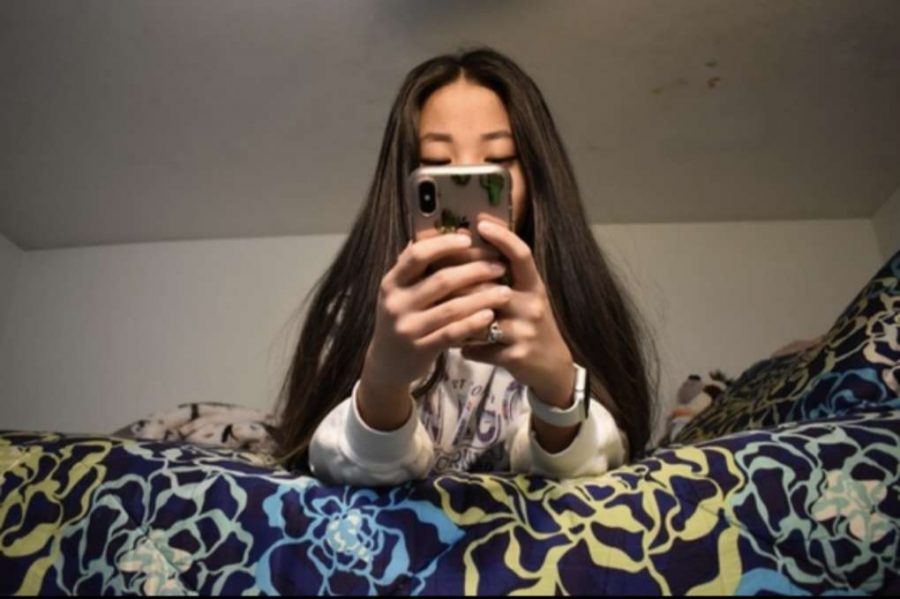Students adapt to COVID-19 shutdown from home
Junior Clare Miller looks at her phone in her bedroom. She said the pandemic has made her appreciate what she has.
March 26, 2020
Students and families across the globe have faced the consequences of COVID-19 spreading rapidly. Nearly 500,000 cases have been confirmed worldwide as of March 25. The United States has more than 68,0000 cases and more than 1,000 deaths as a result of the virus. Due to the coronavirus’ ability to exist on surfaces and spread easily through close contact with others, necessary steps have been taken to better prepare for the rising number of cases. The goal is to mitigate the disease and avoid overflowing hospitals with sick patients, as well as informing the public on how to protect others; young, healthy people can tolerate and recover from symptoms of COVID-19 easier than older or immunocompromised individuals. Regardless, scientists and medical experts are working tirelessly to slow the rate of infection and “flatten the curve” by testing potential vaccines and medications to fight the illness and minimize its effects.
Radical actions, such as school closings, shuttering “non-essential businesses,” high school test cancellations and modifications, and restrictions on food business operations have put people in a state of uncertainty, but will prove to lessen growth of diagnosed cases, if executed properly. South Korea, for example, has modeled the importance of preparedness and immediate intervention; according to sciencemag.org, as of March 17th, the country has tested at least 5,200 tests per one million people, compared to the United States’ 74 tests per million. Increasing testing and isolating infected individuals has led to dramatic decreases in reported cases, providing hope to countries who may model South Korea’s decisions. For the safety of all, the world has been put in a temporary standstill as hundreds of millions experience life in isolation and perform social distancing, taking precautions to aid the general good. Partaking in online education for K-12 and those in college has become the new normal, but how has it affected the routines of students?
Despite the grim media coverage of these events, some students have found positive ways to use their time off. “I am able to catch up on sleep and focus more on the world around me,” explained Junior Clare Miller. “I have started to appreciate what I have more because a lot has been taken away while being ‘quarantined.’” Whether it be taking more time for self-care, relaxation, or picking up a new hobby, the days spent at home have led to more creative avenues for students that they may not have time for during the typical school year. Others have engaged in learning activities from home, exploring new subjects of interest or practicing skills needed later on, like preparing for SAT and AP exams. Those who are often busy with athletics and academics have enjoyed the looser schedule set without school: “I have more freedom throughout the day, and I am on my own schedule, which is nice for a change,” said Sophomore Gracie Smetana.
Many students have also experienced negative consequences without structured learning; the lack of deadlines and assignments has left many in an unmotivated state, filled with apprehension for what returning to school will be like. “I have struggled to stay motivated knowing that the work I do for my classes probably won’t go into the grade book,” stated Junior Kristen Schang. With no routine or agenda to keep one in line, staying on-task with no homework has proven difficult for even the most dedicated students. “ I like to be busy and have tasks constantly throughout the day, so that has been difficult,” Smetana added. “I have been getting a little stir-crazy though because usually I’m out of the house almost all day.”
Unlike other vacations or breaks during the school year, students are advised not to spend time with friends or participate in group activities. This has only accentuated the boredom that has prevailed among children no longer in the classroom: “I always find myself complaining about how bored I am without school, and I can not see all my friends. I am waking up later and not taking much advantage out of the day,” Miller shared. “ I get sick of doing the same stuff over and over, and when I am stuck in my house, everything gets boring after an hour.” With little to do and minimal sources of entertainment, an extended spring break has become less appealing to displaced students without a set routine.
These sudden changes in students’ day-to-day plans have inspired new activities to take the place of school. Some have taken their academics into their own hands, knowing that when students are permitted to attend school again, the fast-paced lifestyle will return. Schang feels pressure to keep up with her studies, but also values indulging in her freetime: “I am studying for the SAT that juniors will take right when school is back, but I [also] hope to finish some school work and see how much Disney Plus I can watch.” Miller has also used this time to enjoy the smaller things she once took advantage of. “I am also using this time to become closer with my family, as I am not home much when it comes to school and sports. I hope this time off helps me see the greater picture in life and to not take everything for granted,” she said.
Finding ways to pass the time and build a routine is crucial to being productive while trapped indoors. It is encouraged to find distractions that will foster positive thinking and growth, inspiring one to have hope in spite of the international tragedy occurring. Stay safe, healthy, and optimistic, MHS!
